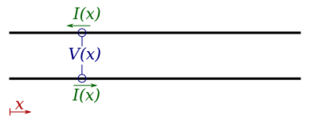Physics:Characteristic admittance
From HandWiki

Characteristic admittance is the mathematical inverse of the characteristic impedance. The general expression for the characteristic admittance of a transmission line is:
where
- is the resistance per unit length,
- is the inductance per unit length,
- is the conductance of the dielectric per unit length,
- is the capacitance per unit length,
- is the imaginary unit, and
- is the angular frequency.
The current and voltage phasors on the line are related by the characteristic admittance as:
where the superscripts and represent forward- and backward-traveling waves, respectively.
See also
References
- Guile, A. E. (1977). Electrical Power Systems. ISBN 0-08-021729-X.
- Pozar, D. M. (February 2004). Microwave Engineering (3rd ed.). ISBN 0-471-44878-8.
- Ulaby, F. T. (2004). Fundamentals Of Applied Electromagnetics (media ed.). Prentice Hall. ISBN 0-13-185089-X.
 |
